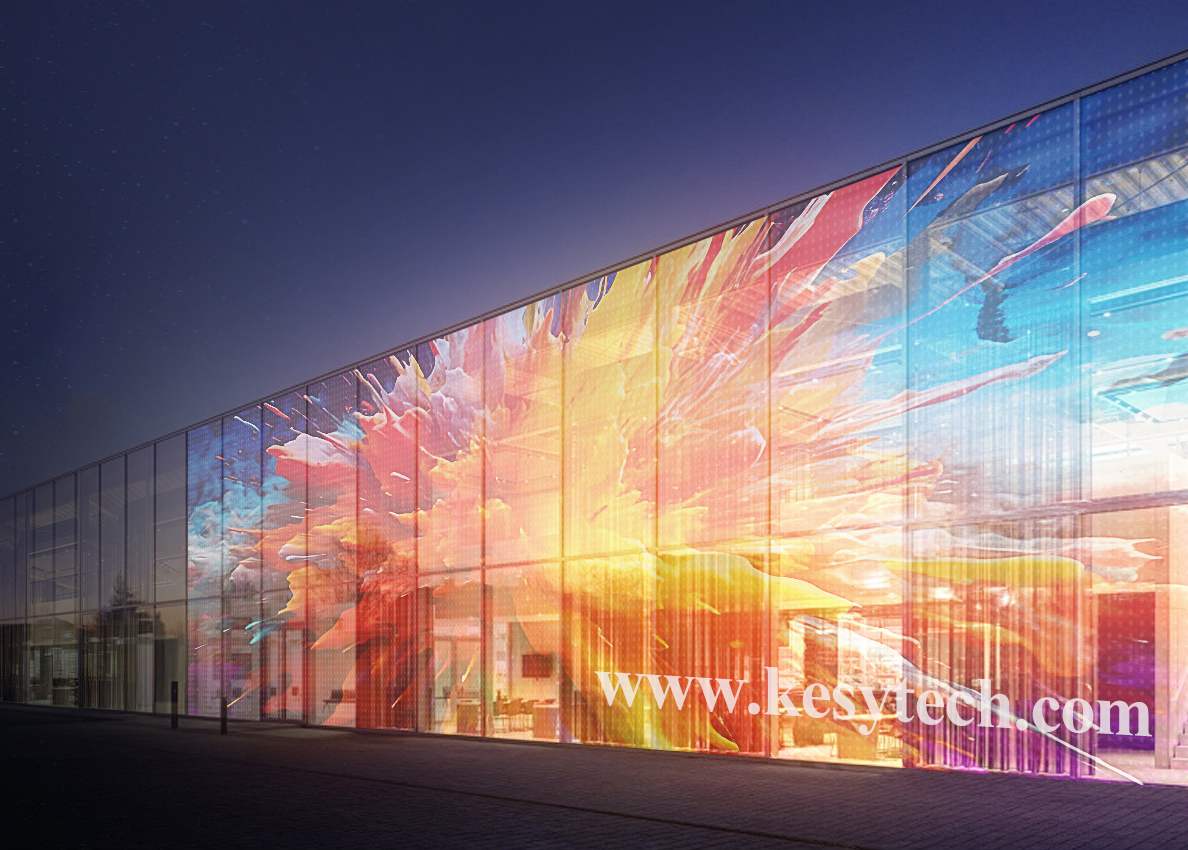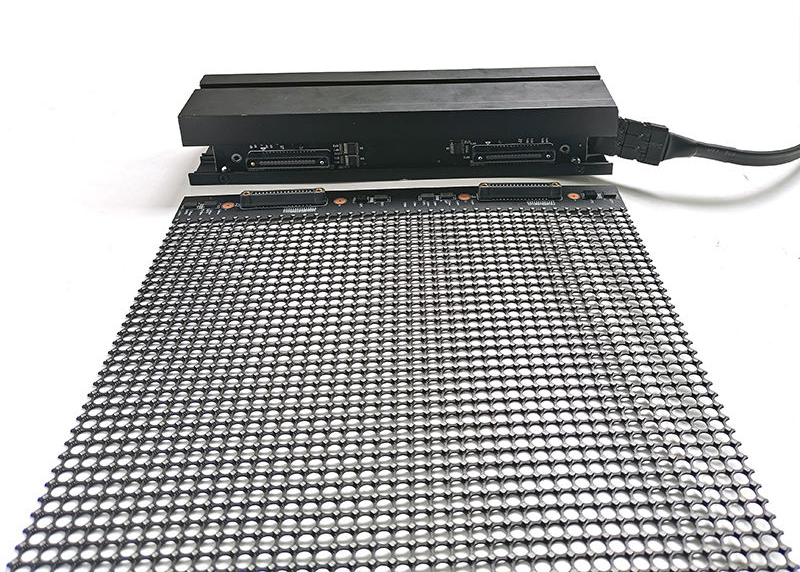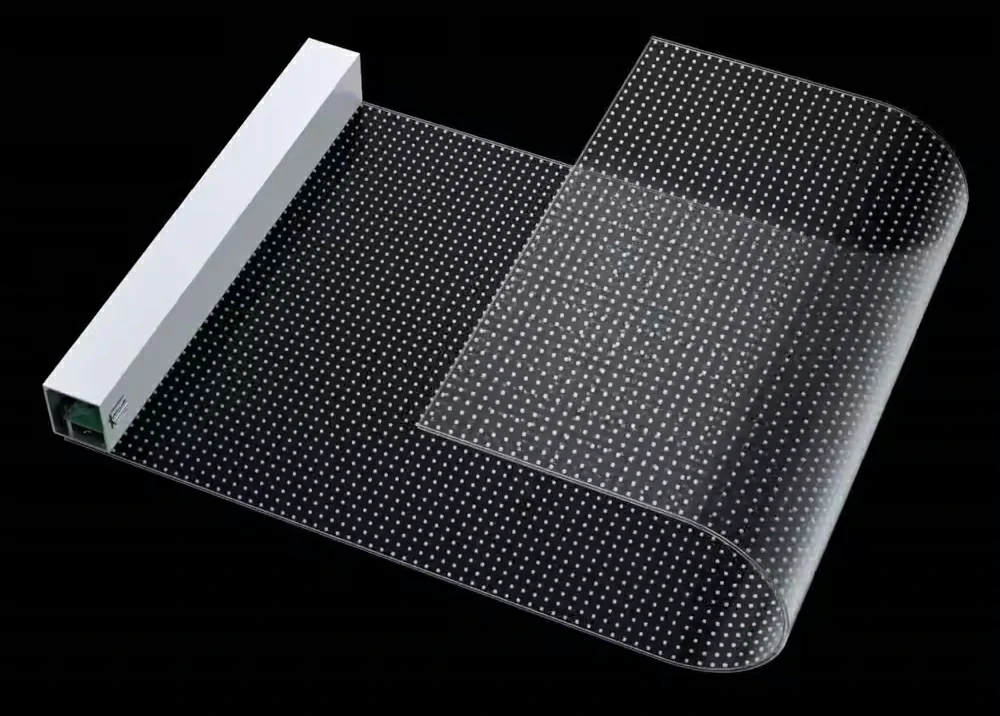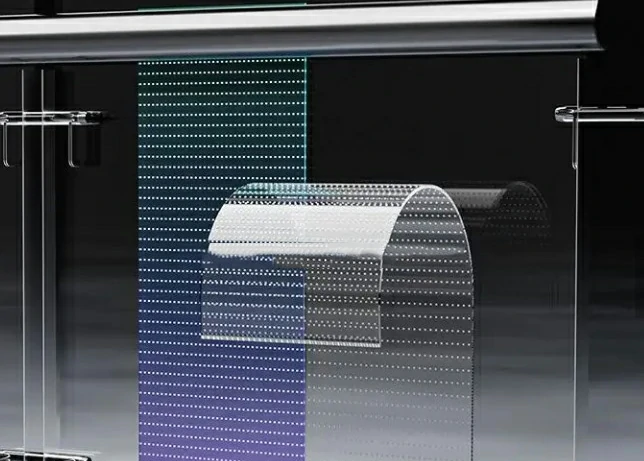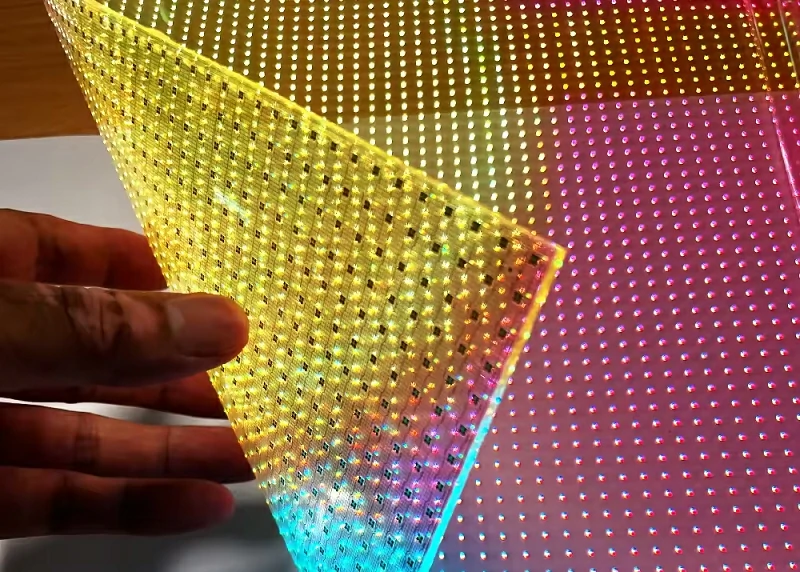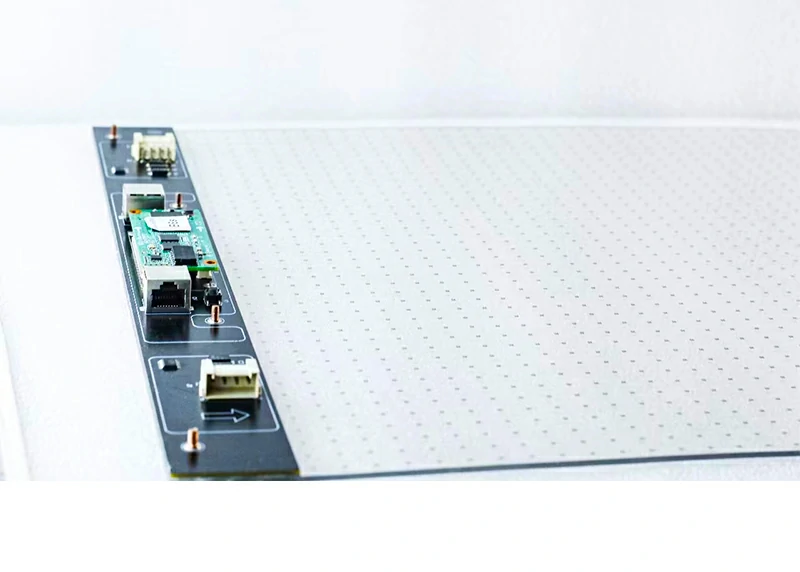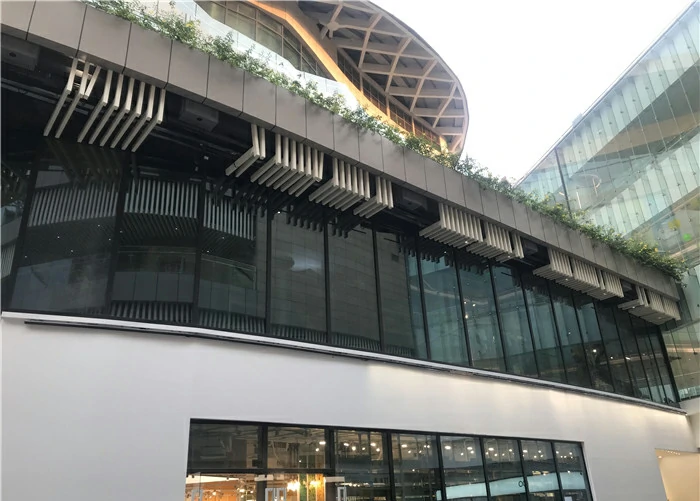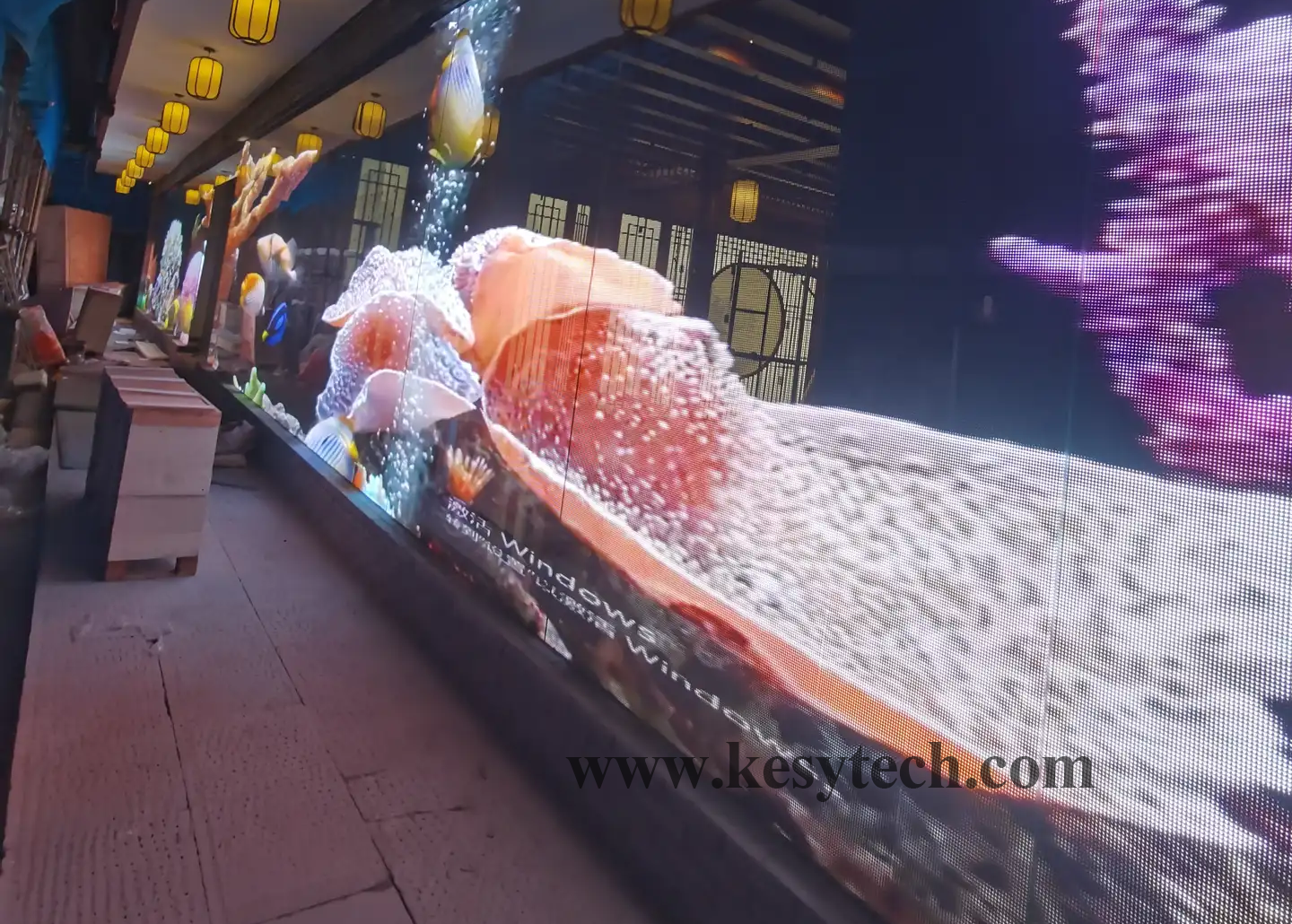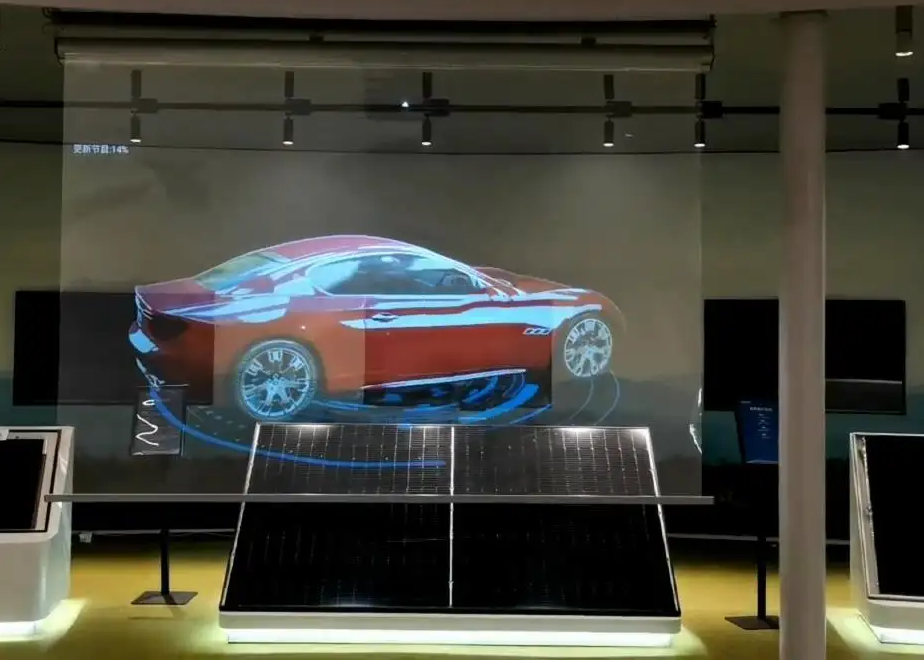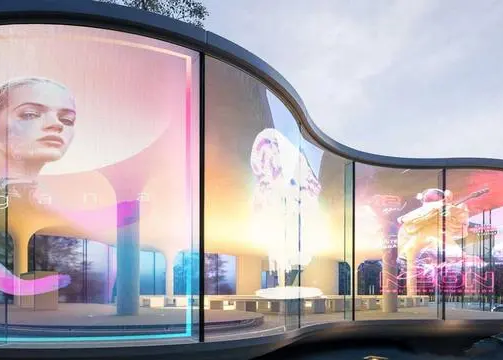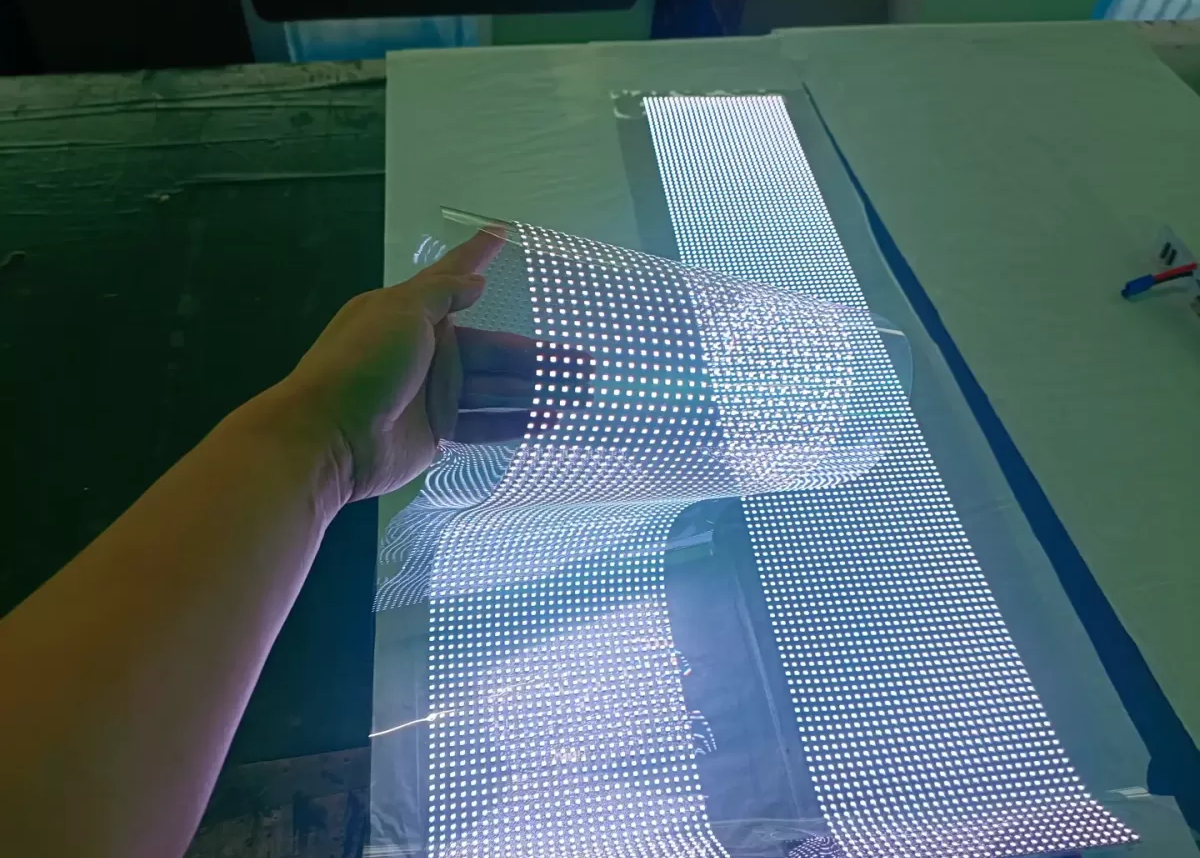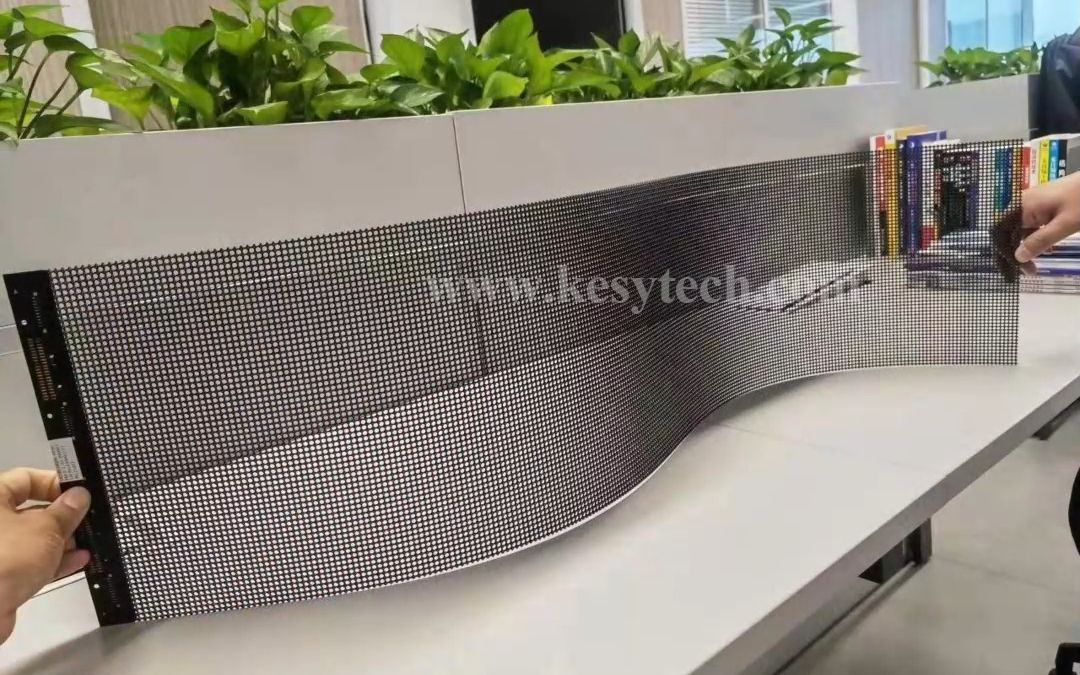
1.What is a holographic screen? (1)
Holographic screen is a display technology that can create three-dimensional images or animations that seem to be suspended in the air. Unlike traditional flat display technology, holographic screen can present a realistic three-dimensional effect, giving people an immersive and tactile illusion.
2.LED holographic screen technology principle
LED light array:LED holographic screens are made up of hundreds or thousands of small LED lights. These LED lights are arranged in an array, usually on a plane. Each LED light can be independently controlled for brightness and color.
Spatial light modulation: The basic principle of LED holographic screen is to generate interference and diffraction effects of light waves through spatial light modulation. Each LED light emits light at different time points, generating a series of light waves.
Generate wavefront: By controlling the brightness and color of the LED light, a specific wavefront can be generated, which is the shape of the leading edge of the light wave propagating in space. The wavefront can be flat, spherical, or other shapes.
Holographic encoding: In order to display a specific holographic image or animation, the desired image needs to be converted into the corresponding holographic encoding. This usually involves decomposing the image into components of interference and diffraction of multiple light waves.
Optical reflection and refraction: Behind the LED holographic screen, a lens or reflector is usually placed. These optical components can reflect and refract the light waves emitted by the LED to form a visible three-dimensional image in the air.
Stereoscopic image viewing:Through the perspective of the observer, you can see the stereoscopic image formed in the air. Due to the interference and diffraction effects of light waves, the observer can see the image from different angles, creating a three-dimensional illusion.
There are many holographic screen technologies, including transmissive holographic screens, reflective holographic screens, and TV-type holographic screens. Transmissive holographic screens form images by transmitting light beams through objects, reflective holographic screens present images by reflecting light beams on the surface of objects, and TV-type holographic screens apply holographic technology to the field of TV display to achieve visual holographic video playback.
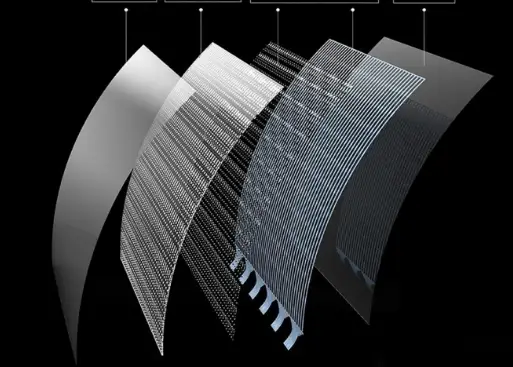
3.What are the holographic products?
Holographic products are products made using holographic screen technology. Here are some common holographic products:
Holographic mobile phone: A holographic mobile phone is a smart phone with holographic screen technology. It can display realistic three-dimensional images and videos, providing users with a different visual effect from traditional flat screens.
Holographic glasses: Holographic glasses are wearable devices equipped with holographic screen technology. They can present images in virtual reality and augmented reality applications in holographic form, allowing users to view realistic three-dimensional content in real environments.
Holographic projection equipment: Holographic projection equipment uses holographic screen technology to project images into the air, creating a three-dimensional effect that seems to be suspended in the air. This equipment is usually used for displays and demonstrations, and can produce eye-catching effects in various occasions.
Holographic Display: Holographic Display is a special device that can display products, models or images in holographic form. It can be used in business exhibitions, product demonstrations, education and other occasions to attract the attention of the audience.
4.Characteristics of LED holographic display(2)
One.Ultra-thin design
The thickness of the LED holographic transparent screen is less than 2MM, it is light and transparent, and will not block the background, making the visual effect more transparent. Weighing only 3KG per square meter, it is bendable, cuttable, and flexible to use, just like a large “film”. It uses a special adhesive with an adhesive force equivalent to 6 kg/square meter, and is firmly adsorbed on transparent glass.
Two.high definition and bright
The sensory permeability of the entire series of products can reach over 80%, and the number of pixels in the same area is 4 to 5 times that on the market. There is no stripe segmentation effect, and the pixels are invisible to the naked eye from 3 meters away, making it truly HD highlights.
Three.Autonomous driver IC
The use of self-developed IC with extremely strong driving force, coupled with high-quality materials and full-standard processes, ensures the high performance and stability of the holographic transparent screen. With high standards of craftsmanship and clever design, the entire screen is truly transparent. Among them, the pixels with equal spacing P3.91 can achieve 80% sensory transparency, and the pixels with equal spacing P6.25 can achieve 90% sensory transparency. They are mounted on transparent glass and appear as a “screen” when displayed. When the lights are off, it is a “transparent film screen”.
Four.Immersive experience
The design of the LED holographic transparent screen enables the three-dimensional fusion of the scenes before and after the screen and the images on the screen, forming a strong three-dimensional sense of suspension and bringing an immersive experience to users.
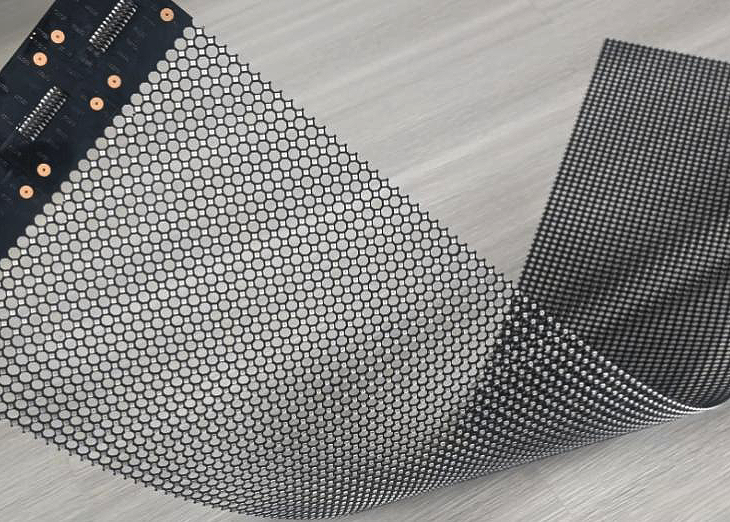
Five.Energy saving and environmental protection
The LED holographic transparent screen uses energy-saving and environmentally friendly materials. The design pursues ultra-light, ultra-thin and high transparency, which significantly reduces energy consumption. Different from traditional LED displays, transparent LED screens have a softer display effect and reduce the impact of light pollution on the environment. . The materials used are not only environmentally friendly, but can also be recycled and reused to reduce the environmental burden at the source. The holographic screen optimizes energy use through the intelligent control system, further improving the energy-saving effect.
5. Advantages of LED holographic display(3)
One.Super strong visual appeal
The unique image playback effect of the holographic LED display has a strong visual appeal and is very suitable for applications in multiple scenarios such as marketing, advertising and entertainment industries.
Two.Interactivity and participation
The holographic LED display can interact with the audience through gesture recognition or touch interaction technology, greatly enhancing the user’s sense of participation.
Three.Multi-purpose
Holographic LED displays can be widely used in various occasions, including retail stores, exhibition halls, museums, and various large-scale event sites. They can be used to display products and other information, and can present the corresponding content with more unique visual effects.
four.Scalability
The size of the holographic LED display can be enlarged or reduced to suit different space requirements from small installations to large displays.
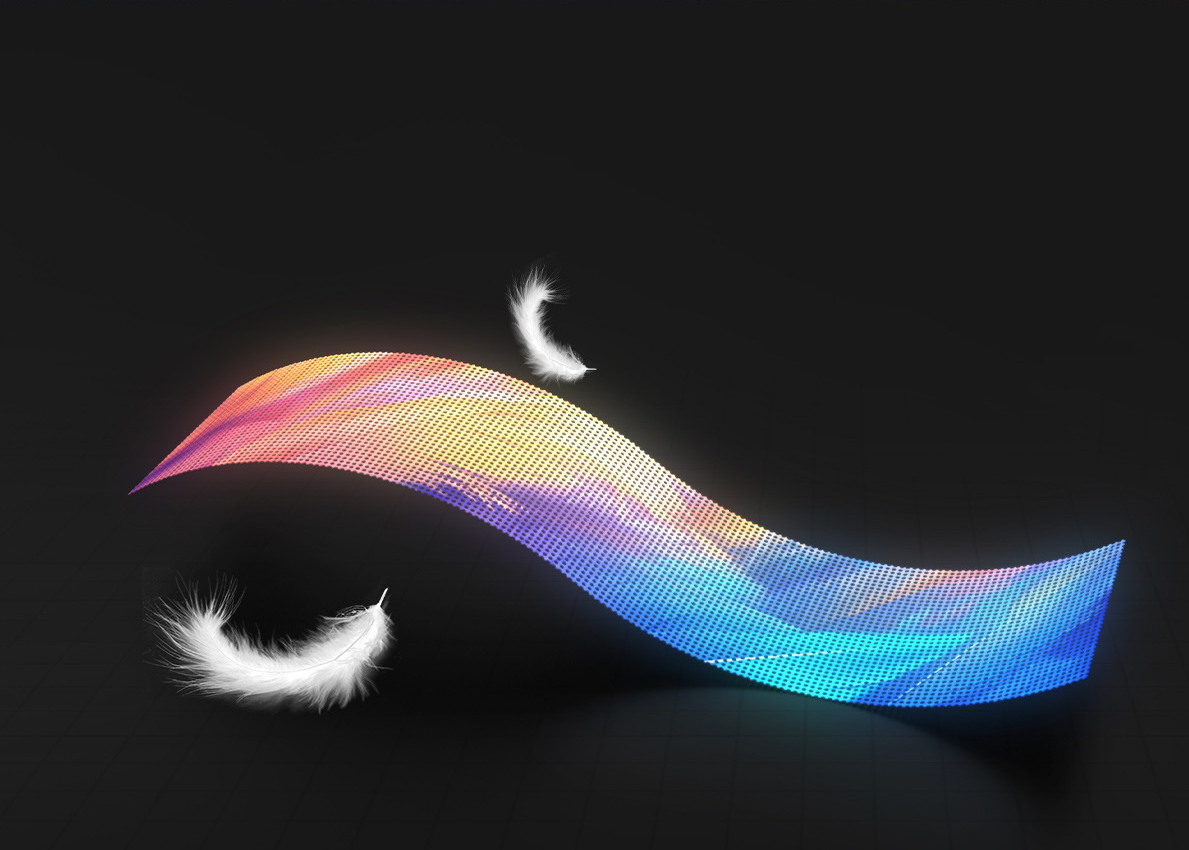
6. Limitations of holographic LED displays
One.Limited viewing distance
Holographic LED displays usually have a limited effective viewing distance. As the viewer moves away from the display, the perception of the 3D effect diminishes.
Two.High cost
Compared with ordinary LED displays, holographic LED displays are more expensive to produce, mainly due to technical costs, system complexity, and professional content creation. These factors combined together lead to the generally high cost of holographic LED displays.
Three.Challenging holographic content creation
Creating 3D holographic content is technically challenging and often takes a lot of time to complete. The content must be carefully designed to maximize the effectiveness of the holographic 3D image effect and ensure visual coherence.
Four.Low content compatibility
The holographic LED display can achieve the best visual effect only when it plays professionally designed holographic 3D image content; however, its compatibility with ordinary 2D image content is extremely poor, so its use is highly limited.
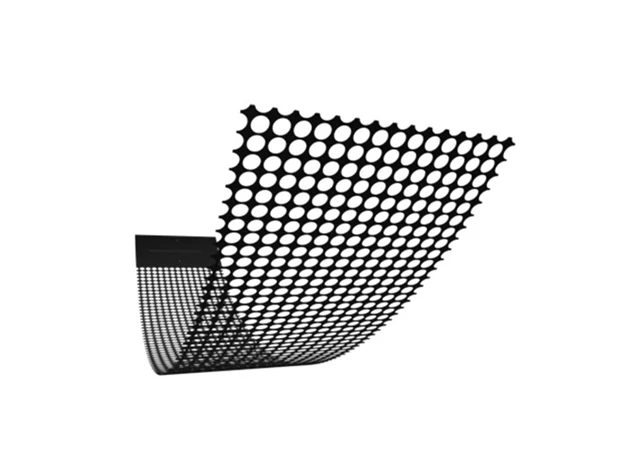
7.Cost and feasibility of LED holographic screens
The cost and feasibility of LED holographic screens vary depending on multiple factors, including screen size, resolution, technical complexity, and market demand. The following are general considerations for the cost and feasibility of LED holographic screens:
Manufacturing cost: The manufacturing cost of LED holographic screens is usually high. This is because the LED light array requires a large number of LED components, as well as complex optical components and control systems. In addition, the manufacturing process may also involve high-precision calibration and adjustment, which increases the cost.
Material Cost:The materials used in LED holographic screens may also have an impact on the cost. High-quality LED lights, optical components, and auxiliary equipment may increase manufacturing costs. In addition, special material requirements and supply chain costs may also increase the overall cost.
Resolution and size: The higher the resolution and size of the LED holographic screen, the higher the cost. High resolution requires more LED lights and a more complex control system. Large screens require more components and a larger manufacturing process.
Viewing angle and viewing experience: The viewing angle of the LED holographic screen is crucial to the viewing experience. A larger viewing angle usually requires more complex optical design and additional technical support, which may increase costs.
Application fields and market demand: The feasibility of LED holographic screens is also related to specific application fields and market demand. Some industries and venues may be more willing to invest in novel display technologies, while other fields may be cost-sensitive or have low demand.
Although the cost of LED holographic screens may be high at present, it is expected to gradually decrease as the technology advances and the market matures. This will make LED holographic screens more feasible and adopted in a wider range of applications. In addition, as market demand grows, more competition and innovation may emerge, driving cost reduction and technological improvements.
8.LED holographic screen specifications
| Model | RS-P6.25 | RL-P6.25 |
| Pixel spacing | L(6.25mm)W(6.25mm) | L(6.25mm)W(6.25mm) |
| Pixel density | 25660 points /㎡ | 25660 points /㎡ |
| Module size | 1200mm*250mm | 1500mm*250mm |
| LED light | 1515(light drive in one) | 1515(light drive in one) |
| Breakpoint continuation | √ | √ |
| Thickness | 1-3mm | 1-3mm |
| Power Consumption | Avg:200W/㎡,Max:600W/㎡ | Avg:200W/㎡,Max:600W/㎡ |
| Weight | Less than3kg/㎡ | Less than3kg/㎡ |
| Permeability | >80% | >80% |
| Life span | >100,000 | >100,000 |
| Power supply requirement | 220V±10%;AC50HZ,Three-phase five-wire | 220V±10%;AC50HZ,Three-phase five-wire |
| Brightness | White balance brightness 2000-4500cd/㎡; automatic and manual adjustment according to ambient brightness | White balance brightness 2000-4500cd/㎡; automatic and manual adjustment according to ambient brightness |
| Angle of view | H160,V140 | H160,V140 |
| Grayscale level | ≥16(bit) | ≥16(bit) |
| Color Temperature | 5500K-15000K(Adjustable) | 5500K-15000K(Adjustable) |
| Drive mode | static state | static state |
| Attenuation rate | Less than 0.05% in 2 years | Less than 0.05% in 2 years |
| Refresh rate | >3840HZ | >3840HZ |
| MTBF | > 10000H | > 10000H |
| LED bead failure rate | less than one ten thousandth and is discretely distributed | less than one ten thousandth and is discretely distributed |
| Control system | Colorlight/Nova Synchronous/Asynchronous | Colorlight/Nova Synchronous/Asynchronous |
| Use environment | ◆Working environment:-10~+65℃/10~90%RH ◆Storage environment:-40~+85℃/10~90%RH | ◆Working environment:-10~+65℃/10~90%RH ◆Storage environment:-40~+85℃/10~90%RH |
| Installation mode | Mounting, lifting, fixing, support any size cutting, bending | Mounting, lifting, fixing, support any size cutting, bending |
9.What are the application scenarios of holographic screens?
LED holographic transparent screens are widely used, mainly in advertising and marketing, retail and exhibitions, training and education, museums and galleries, etc. Whether in commercial display or cultural entertainment, LED holographic transparent screens can attract people’s attention with their unique transparent characteristics and powerful display functions. You can learn more about the specific application areas through the following content
Advertising and Marketing
Holographic LED screens are often used in advertising and marketing activities to create an eye-catching immersive experience. Playing visually impactful product or brand image information through holographic LED display screens can attract more attention, better promote products and enhance brand awareness.
Retail and Exhibition
Holographic LED screens are often used in commercial centers and large exhibition venues where the retail industry is concentrated to display products, demonstrate functions or provide interactive experiences. Creating virtual product displays, 3D models or animations through holographic LED screens can achieve twice the result with half the effort in publicity.
Training and Education
LED holographic transparent screens are also commonly used in education and training institutions, especially in medical training, construction or engineering. They are mainly used to display 3D models and virtual environments to provide students with an enhanced visual experience.
Museums and Galleries
Museums and art galleries also often use holographic LED screens to play holographic 3D images to achieve a more experiential interactive exhibition effect, generally with educational or storytelling video content. The unique effect of holographic 3D images can give historical events, cultural relics or artworks a sense of reality that integrates into real life.
Hospitality and Tourism
In the hotel and tourism industry, holographic LED displays are also used to display fascinating multimedia information, such as introductions to tourist destination highlights, route information, virtual tours of attractions, etc., to attract more traffic and increase tourism and hotel revenue. 6.Entertainment performances and large-scale events LED holographic transparent screens are also commonly used in entertainment performances and large-scale events. Through the holographic LED display screen, the holographic image of the performer is projected to create a 3D visual effect, giving the audience a more immersive visual experience, which can comprehensively enhance the overall effect and atmosphere of entertainment performances and activities.
Product launches and demonstrations
LED holographic transparent screens are used for product launches and demonstrations to create memorable and impactful visual experiences. They can display 3D product renderings, animations, or interactive content to help communicate the features and benefits of a product or concept.
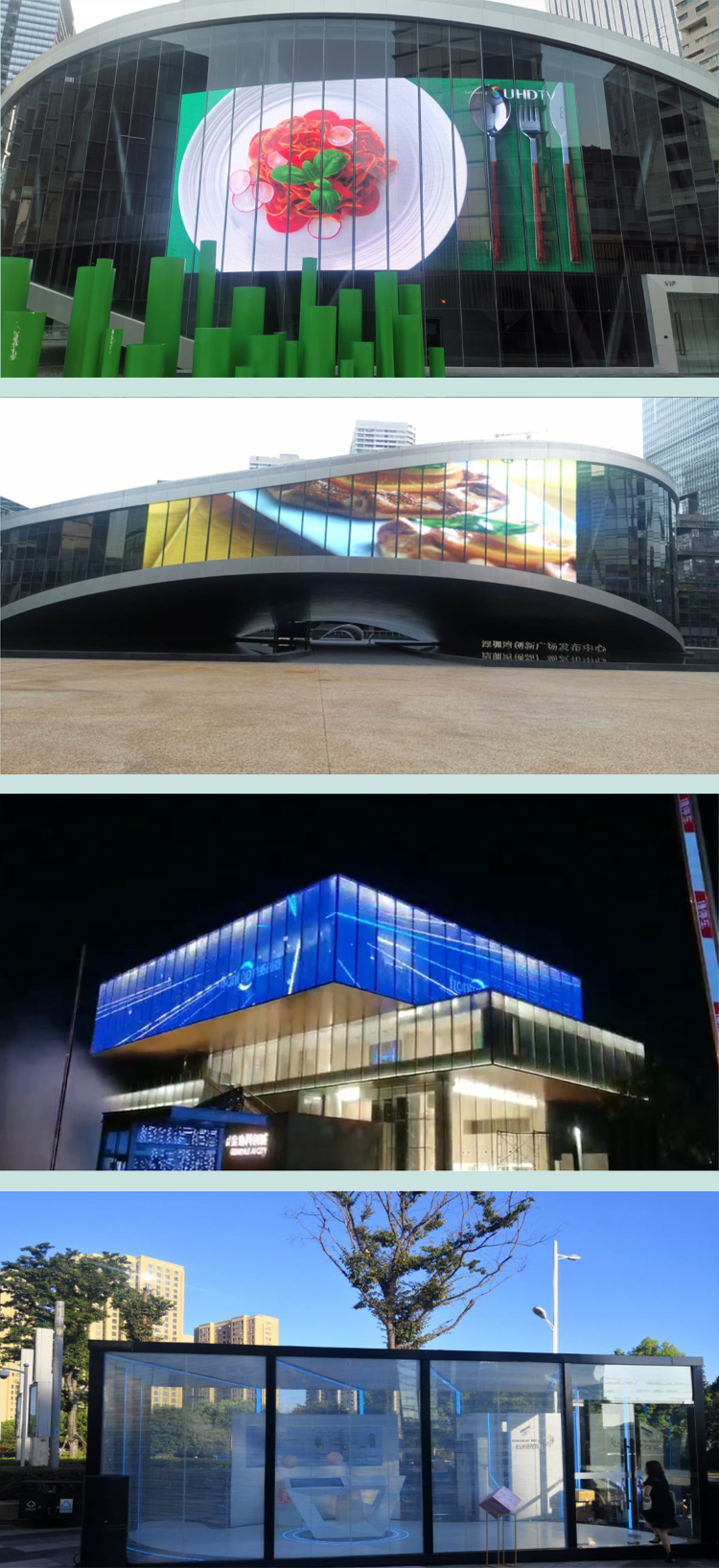
10.Development trend of holographic screen technology
Holographic screen technology is an evolving field, and here are some of the trends in holographic screen technology:
Improved Visualization: A major goal of holographic screen technology is to provide more realistic and lifelike three-dimensional images. Future developments will focus on enhancing image clarity, color vividness, and dynamic range to achieve more realistic visuals.
Multi-angle viewing:Current holographic screen technology usually requires viewers to view images from a specific angle to achieve the best effect. Future developments will focus on achieving multi-angle viewing, allowing viewers to enjoy stereoscopic images from different positions and angles.
Increase interactivity: The development of holographic screen technology will also focus on increasing interactivity. People want to be able to interact with holographic images, such as controlling and manipulating images through gesture recognition or touch.
Miniaturization and Portability: Current holographic screen technology typically requires large equipment and complex setups. Future developments will focus on achieving greater miniaturization and portability, allowing holographic screens to be integrated into a variety of devices, such as smartphones, glasses, or wearables.
Innovative application areas: The application areas of holographic screen technology still have great development potential. In addition to entertainment and advertising, holographic screen technology may find wider applications in education, medical care, design, virtual reality and augmented reality.
11.Do you need a LED holographic screen?
If your product requires an eye-catching display, LED holographic screens can present images and video content in a very eye-catching way. If you need to attract the attention of the audience at an exhibition, event or store, LED holographic screens can help you achieve this goal.
If your product requires branding, holographic screens can be used to enhance brand image and promotional activities. You can create attractive advertisements and branded content to increase brand awareness and recognition.
If you want to express the innovation and uniqueness of your product: Holographic screens are generally considered a unique and high-tech way of display that can enhance your image and attract more target audiences.
